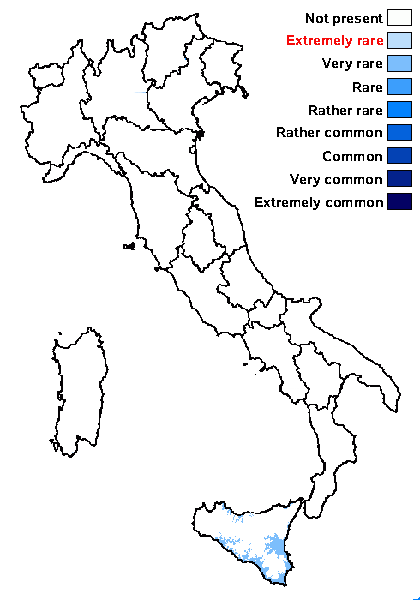Verrucaria eggerthii J. Steiner
Verh. zool.-bot. Ges. Wien, 61: 40, 1911.
Synonyms:
Distribution: S - Si (Grillo 1998, Grillo & Caniglia 2004, Grillo & al. 2007b).
Description: Thallus crustose, hemiendosubstratic, whitish grey, smooth and continuous. Upper cortex (lithocortex) poorly developed; medulla prosoplectenchymatous, with oil cells (macrosphaeroids) in lower part. Perithecia black, bottle-shaped, up to 0.6 mm across and to 0.7 mm high, completely immersed in the rock and leaving pits when they fall off. Involucrellum absent; exciple pyriform, colourless except near the ostiole where it is brown-black; hamathecium of periphyses in the ostiolar canal, and short periphysoids in the half upper part of the perithecial cavity; hymenial gel hemiamyloid, I+ red (I+ blue at very low concentrations of I), K/I+ blue. Asci 8-spored, clavate, I-, fissitunicate, the wall thickened above, with an ocular chamber, dehiscent by extrusion of an endotunica to form a delicate rostrum, Verrucaria-type. Ascospores 1-celled, hyaline, ellipsoid, 29-39 x 12.5-16 μm. Photobiont chlorococcoid. Spot tests: K-, C-, KC-, P-, UV-. Chemistry: without lichen substances.Note: a saxicolous eu-Mediterranean species known only from the type locality in Corfu (Greece), from Croatia, and from Sicily. The first Italian record (see Nimis 1993: 738) was probably identified by Servìt.
Growth form: Crustose
Substrata: rocks
Photobiont: green algae other than Trentepohlia
Reproductive strategy: mainly sexual
Poorly known taxon in need of further study
Commonnes-rarity: (info)
Alpine belt: absent
Subalpine belt: absent
Oromediterranean belt: absent
Montane belt: absent
Submediterranean belt: absent
Padanian area: absent
Humid submediterranean belt: absent
Humid mediterranean belt: absent
Dry mediterranean belt: very rare

Predictive model
Growth form: Crustose
Substrata: rocks
Photobiont: green algae other than Trentepohlia
Reproductive strategy: mainly sexual
Poorly known taxon in need of further study
Commonnes-rarity: (info)
Alpine belt: absent
Subalpine belt: absent
Oromediterranean belt: absent
Montane belt: absent
Submediterranean belt: absent
Padanian area: absent
Humid submediterranean belt: absent
Humid mediterranean belt: absent
Dry mediterranean belt: very rare

Predictive model
 Index Fungorum
Index Fungorum
 GBIF
GBIF

